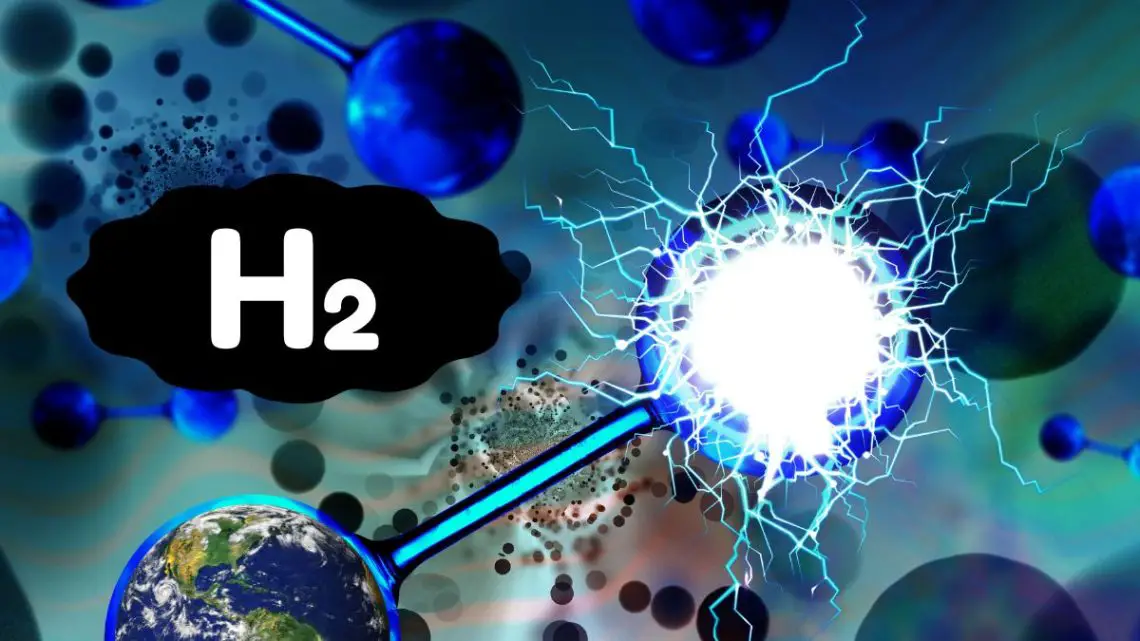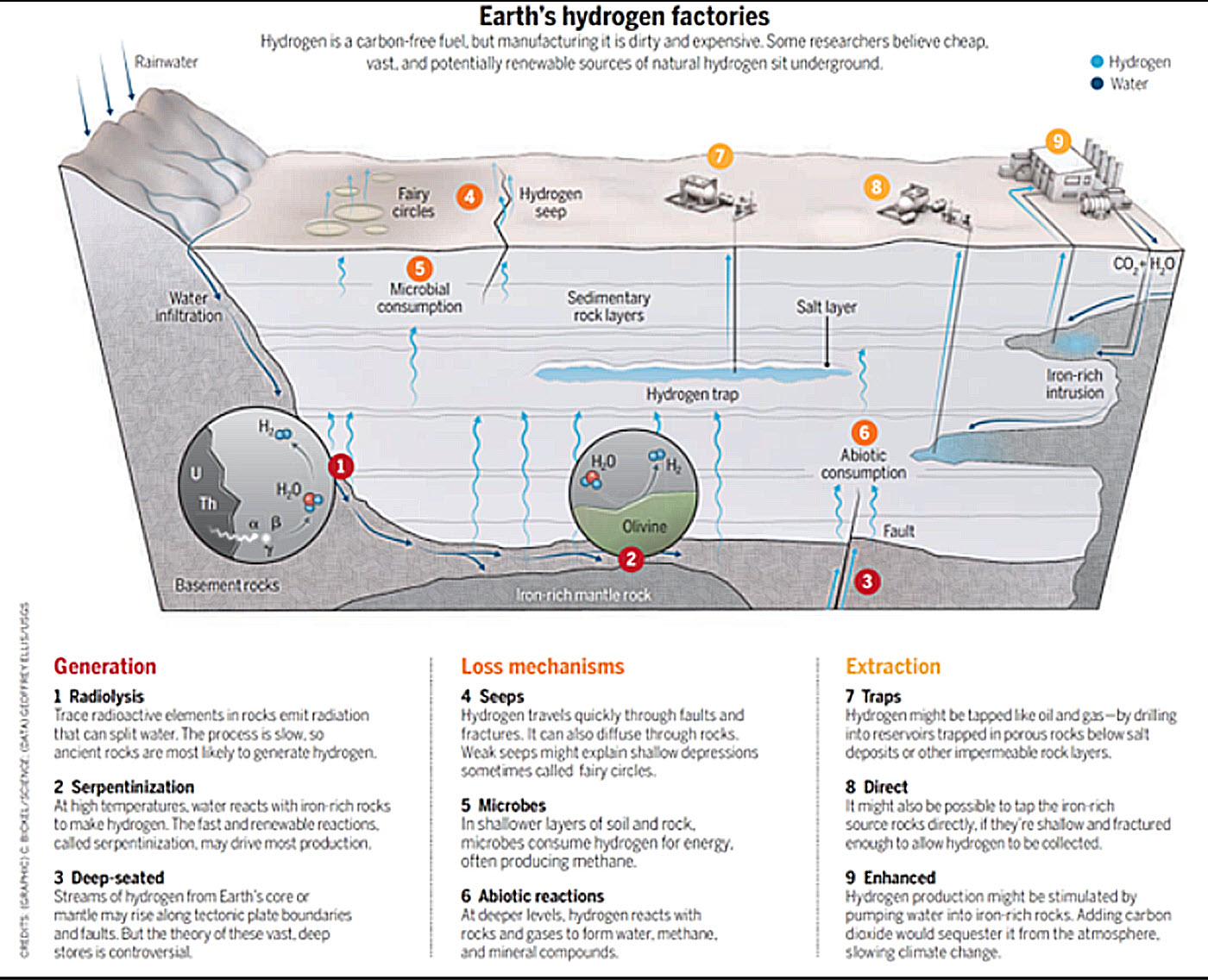
Unearthing Natural Hydrogen – The Invisible Power Source Fueling Curious Minds
February 7, 2024 0 By Jake BanksWe’re on the brink of a green energy revolution, with natural hydrogen or sometimes referred to as white hydrogen, offering untapped potential. This piece explores hydrogen’s natural sources, from oceanic hydrothermal vents to deep geological formations, revealing how water and minerals combine to create this abundant element. We’ll investigate how we can capture this invisible power source, through cutting-edge extraction and detection methods, and discuss the challenges of transitioning to cleaner energy.
Natural Hydrogen Sources
Unveiling Natural Hydrogen: Earth’s Primary Sources
Natural Hydrogen: A Primordial Constituent
Hydrogen is the universe’s simplest and most abundant element, foundational to the grand tapestry of the cosmos. Notwithstanding its cosmic prevalence, hydrogen is much rarer as a free element on Earth due to its predilection for forming compounds. Despite this, our planet does harbor sources of natural hydrogen, which are of considerable scientific interest and technological promise.
I. Biogenic Hydrogen Generation
A. Microbial Metabolism: Biohydrogen Production
The most prevalent terrestrial source of natural hydrogen is biogenic, derived from the metabolic activities of microorganisms. Microbes within certain ecological niches can produce hydrogen gas (H2) as a byproduct of fermentation. Typically, this process occurs under anaerobic conditions, whereby organisms break down organic substances, freeing hydrogen in the process. Such biohydrogen, while diffuse, represents a significant area of research due to its potential for sustainable energy sourcing.
II. Geochemical Hydrogen Production
A. Serpentinization: A Reaction Deep Within Earth’s Mantle
Beyond biological pathways, Earth’s geology provides avenues for natural hydrogen generation. The process most widely acknowledged is serpentinization: a geochemical reaction between water and certain minerals from Earth’s mantle, such as olivine and pyroxene. When these minerals come into contact with water at high pressures and moderate temperatures, they transform into a new type of rock called serpentinite. This reaction results in the release of molecular hydrogen as a byproduct.
B. Radiolysis: The Role of Natural Radioactivity
Another less common but observable source of natural hydrogen is radiolysis, which occurs when radioactive decay within the Earth’s crust leads to the dissociation of water molecules into hydrogen and oxygen. The radioactive elements buried in Earth’s crust, like uranium and thorium, emit high-energy particles capable of breaking the chemical bonds of water. This produces free hydrogen, which can accumulate in underground pockets.
III. Hydrogen from Hydrothermal Vents
Finally, hydrothermal vents deep in the ocean floor are also recognized as natural contributors to Earth’s hydrogen budget. These vents, typically found at tectonic plate boundaries, discharge hot, mineral-rich water that can transport hydrogen from Earth’s interior to the deep-ocean environment. Research on these vents reveals not only the presence of hydrogen but also the diverse biological communities that harness this energy source, demonstrating the element’s foundational role in supporting life in extreme conditions.
In conclusion, the primary sources of natural hydrogen on Earth are intricately linked to the planet’s living ecosystems and dynamic geology. From microbial actions to the processing of rocks and radioactive decay, each source depicts a facet of Earth’s complex systems. Understanding these natural mechanisms not only unveils the cycles of this elemental constituent but also guides humanity in its pursuit of alternative and sustainable energy solutions.
Unlocking the Secrets of Natural Hydrogen: Detection and Extraction Techniques
Natural hydrogen, a noteworthy contender for a sustainable energy solution, may be elusive but is detectable through advanced scientific methodologies. One such detection method involves the utilization of airborne surveys. These surveys detect the presence of hydrogen gas seeping from underground reserves. The specialized equipment used in these surveys measures anomalies in the local magnetic field which can indicate the presence of hydrogen gas. The allure of such a method lies in its ability to cover large swaths of terrain and its non-invasive nature, leaving the environment undisturbed.
Another prominent technique is hydrogen gas sensing, which is often conducted on-site. Portable hydrogen detectors can measure the concentration of hydrogen in the atmosphere at specific locations. These sensors work on the principle of thermal conductivity, with hydrogen having higher thermal conductivity than air, altering the temperature balance in the sensor and thus signaling the presence of hydrogen.
For the extraction of this valuable resource, technologies leverage the physical properties of hydrogen gas. One exemplary method of extraction is through the use of vacuum systems. These systems evacuate existing air and moisture from the subsurface, exerting a pressure differential that enables the hydrogen gas to migrate towards the source of lower pressure—thus captured, the gas can be condensed and stored.
Alternatively, gas wells can be drilled into hydrogen-rich reservoirs, a process analogous to that of extracting fossil fuels. However, due to the lightness and high diffusivity of hydrogen gas, precise control and sealing technologies must be applied to prevent any escape of hydrogen into the atmosphere during extraction.
Advancements in material science have led to the development of specialized membranes capable of selective gas separation. These membranes can effectively filter hydrogen from other gases, purifying it in the process for subsequent use. This method is particularly advantageous when natural hydrogen is mixed with other hydrocarbon gases, as it allows for the isolation of hydrogen with high efficiency.
Summing Up The Above Steps:
- Detection starts with airborne surveys using spectrometers to identify subterranean hydrogen accumulations.
- On-site gas sensing techniques provide real-time measurements of hydrogen concentrations, essential for assessing the site’s potential and ensuring safe extraction processes.
- Extraction techniques have moved towards vacuum systems that selectively siphon natural hydrogen, presenting a low-impact alternative to conventional drilling.
- When drilling is necessary, specialized gas wells are used, taking environmental impact into account.
- Material science plays a key role in refining these processes, especially in the development of selective gas separation technologies and membranes for hydrogen purification.
As the world shifts towards sustainable energy, scientists are leading the charge, unraveling the potential of Earth’s natural hydrogen reserves. Recognizing the pivotal role of natural hydrogen in a decarbonized future, it’s crucial to comprehend and enhance these methods. Poised on the cusp of an energy revolution, we hold the keys to a wealth of clean energy in the molecules of natural hydrogen beneath our feet.
Environmental Impacts
Harnessing Natural Hydrogen: An Environmental Perspective
Natural hydrogen, bearing the simplest and most fundamental of molecular structures, holds the promise of a cleaner energy future. However, the extraction and usage of this resource must be addressed with a conscientious approach to environmental stewardship.
While the benefits of natural hydrogen are considerable, environmental considerations during its extraction are paramount. The process of extracting hydrogen from natural reserves must be meticulously engineered to prevent ecological disruption. For instance, the alteration of subterranean ecosystems and the potential contamination of groundwater demand careful attention. Moreover, land usage for drilling operations may compete with conservation priorities and indigenous practices.
The deployment of hydrogen as a source of energy necessitates the development of specialized infrastructure for storage and transportation. This includes pipelines, storage tanks, and refueling stations, which must be constructed and operated with the lowest possible environmental impact.
Looking at the broader landscape, the scale at which natural hydrogen may be harnessed has the potential to alter regional and potentially global energy markets. This shift could engender a reduction in the reliance on polluting energy resources, thereby fostering a ripple effect of environmental benefits across numerous ecosystems and communities.
Lastly, the integration of natural hydrogen into the energy matrix must accompany educational efforts to disseminate knowledge about this resource and its technologies. Enlightening stakeholders, including policymakers, industry leaders, and the general public, about the responsible production and application of hydrogen is integral to achieving its full environmental advantages.
In summary, the path towards sustainability requires innovation, collaboration, and dedicated research. Natural hydrogen represents not only a potential green energy solution but also an intellectual challenge showcasing human ingenuity. We’ve seen its multifaceted nature through environmental considerations and ongoing research. Hidden within the earth and flowing in underground reservoirs, natural hydrogen presents an opportunity for a more environmentally friendly future. As our exploration concludes, we understand that our energy story is about to change, ready to incorporate natural hydrogen as an important part of renewable energy.



 HFN News is your leading source for fresh hydrogen and renewable energy updates. Amid the fast-paced growth of hydrogen companies, we provide top-notch news and insights about this exciting sector. Our coverage spans from hydrogen cars to global sustainable initiatives, and we highlight the latest in green jobs and developing hydrogen hubs. We invite you to share your local hydrogen news and explore today’s renewable energy job listings on our site. Thanks for choosing HFN News as your trusted guide to the hydrogen and renewable energy world!
HFN News is your leading source for fresh hydrogen and renewable energy updates. Amid the fast-paced growth of hydrogen companies, we provide top-notch news and insights about this exciting sector. Our coverage spans from hydrogen cars to global sustainable initiatives, and we highlight the latest in green jobs and developing hydrogen hubs. We invite you to share your local hydrogen news and explore today’s renewable energy job listings on our site. Thanks for choosing HFN News as your trusted guide to the hydrogen and renewable energy world!